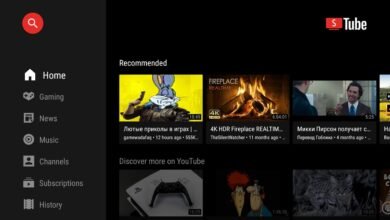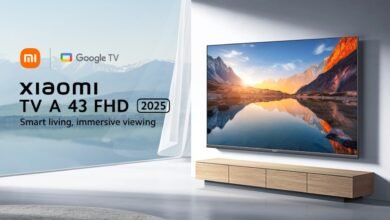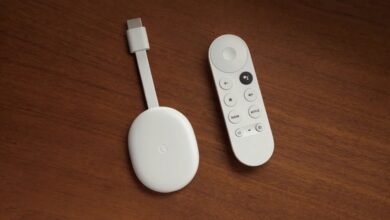
Watch the video below for a more in-depth understanding of all that’s written here. You can get this TV in Kenya for as less as KES. 50,000 and as much as KES. 58,000.
Standout features:
This TV is part of the series 8 TVs from Hisense with the following standout features:
- Local Dimming
- Dolby Vision and Dolby Atmos
- A wide colour gamut
Unibody design
- Vidaa U Smart Operating system
Which means this television doesn’t run Android TV. And if that’s a let down for you, maybe the following things may make you consider buying it. I picked it up for one reason: ULED.
ULED is Hisense’s own approach to bettering the LED screen technology. It is short for Ultra-Light Emitting Diode, and should not be confused to OLED which stands for Organic Light-emitting diode, a more complex, more expensive technology.
I first interacted with the ULED concept through a Linus Tech Tips YouTube video, and I was intrigued. Though the ULED phrasing earlier on was being used for Hisense’s Quantum Dot TVs – something similar to Samsung’s QLED TVs – nowadays they sometimes also use the term on their other budget TVs despite them not featuring quantum dot technology.
This particular TV falling in the budget section means the ULED branding here doesn’t necessarily mean it is using Quantum Dot technology like with Samsung’s and TCLs. But I am not sure about that.
Hisense has said their ULED technology is better as it offers impressive higher 4K HDR picture quality and can get pretty bright while not being very expensive. Over the course of time that I’ve used the TV here are a couple of things I have noticed:
Blacks are good:
I don’t know how to show this to you but I am amazed and impressed by the level of blacks from this panel. I guess the best thing to say is the usual things:
- When watching a movie, blacks are hugely impressive. Like if there is a dark cut, the screen looks like it went completely off.
- When interacting with an interface with a black background, you will notice the difference between the truly black back and the coloured content at the forefront.
This is way better than the black levels on the Samsung RU7100 series I recently had.
I don’t know if this is just because of the local dimming feature, or because of the panel used itself. I think the dimming zones are 60, though information on this is not available on the retail package.
60 is, of course, a small number. Which means you will notice a trail of light around text, or images when the background is supposed to be dark and there’s a bright foreground. If you’re used to OLED panels, this will be a bad thing. If you’re moving from more expensive QLED panels, this will also be an annoying thing. However, if you’ve been using normal LED TVs, this won’t even be a factor you’ll notice. The impressiveness of the blacks, the brightness of the panel, and vibrance of the colours will be all you will care about.
Color reproduction is amazing:
Yeah, this is a 4K panel with an impressive contrast ratio, impressive blacks, and very vibrant colours. I know, since I’ve interacted with LG OLED TVs at their experience zones, that this TV doesn’t come close at all to those, but for a normal watching home experience, I love the colours.
And talking of colors, something else that’s really good is the brightness.
It is an HDR10+ display, I believe, with support for Dolby Vision. So whenever content on the display is Dolby Vision ready (for example content on Netflix) the panel will switch automatically.
Under settings you can change the different display presets. I stick with the dynamic preset because it pushes brightness when needed, and has very good contrast and saturation.
When playing HDR or Dolby Vision content, I use the HDR dynamic preset too because it produces more accurate colors, at least for my eyes. The HDR Day and HDR Night presets are good, but they don’t push the brightness levels I like.
With support for a wider color gamut, the display – I believe with good calibration – can be used for many different purposes.
Operating System:
The operating system is the worst part of this TV. I mean you get an app store, you get the official apps, you get updates and all that. But I don’t know what Vidaa OS is, and I am not ready to learn. That’s why the Mi Box S comes in handy. Though I’ve already switched to the Ematic Box from Safaricom as it offers much more for me with the extra ports. Watch the video on the Ematic box to learn more.
Vidaa OS is not hard to learn though. The only issue is that the remote control feels cluttered. There are many buttons I don’t understand, plus there’s also no microphone so no interaction with the TV via voice. Even on Apps like YouTube that would allow voice input.
Vidaa lacks things like Google Assistant, but that’s to be expected as it isn’t Android. What’s annoying is that the App Store lacks apps you’d want to use locally like Showmax, DSTV now, etc.
If you’re one who uses more apps than just YouTube and Netflix, you’ll need to have an Android TV box for those. Luckily, Hisense has included 4 HDMI 2.0 ports, one that’s ARC ready. Really good. They’ve also included an AV/Component port, two USB ports, an ethernet port, digital audio out port, and a headphone jack. Sweet. They’ve also labelled all ports well.
Gaming:
Since we’ve mentioned game consoles, let’s talk gaming on this panel. I am not a gamer, I have no console, and I probably would have a hard time understanding how to even boot a PS4. So I am not one to trust for anything gaming.
However, given reviews I’ve read of Hisense ULED tvs on gaming, and given that I’ve seen under settings a dedicated setting for gaming offering higher response and lower input lag, it means some work has been done to give gamers an impressive experience.
When gaming mode is on, the screen will know when to make the refresh rate feel much faster so that your gaming input isn’t affected giving you a sweet experience.
Before you ask here are other things to note:
- Yes you can conncect an aerial and watch free to air channels
- Yes the bezels are very tiny, and impressive to look at. But that also means the TV feels really fragile.
- Yes you can watch offline content with the USB Ports
- Yes you can mount the TV, provided you buy your own wall mount.
- Yes there’s no Apple’s Airplay, neither Google’s Chromecast. But you can cast stuff like YouTube, or your entire phone’s screen.
Should you buy?
Get this TV if you want really good contrast, deep blacks, vibrant colours, and an exciting watching or gaming experience at a low budget. Don’t get this TV if you want the smartest TV experience as Vidaa OS is not quite there.
If you don’t have a sound system, you can use the inbuilt speakers from the TV as they’re quite good. Way better than the Samsung’s RU7100 49 inch. The surround sound is also very convincing.
That’s it for the review. Tell me your thoughts down below.







